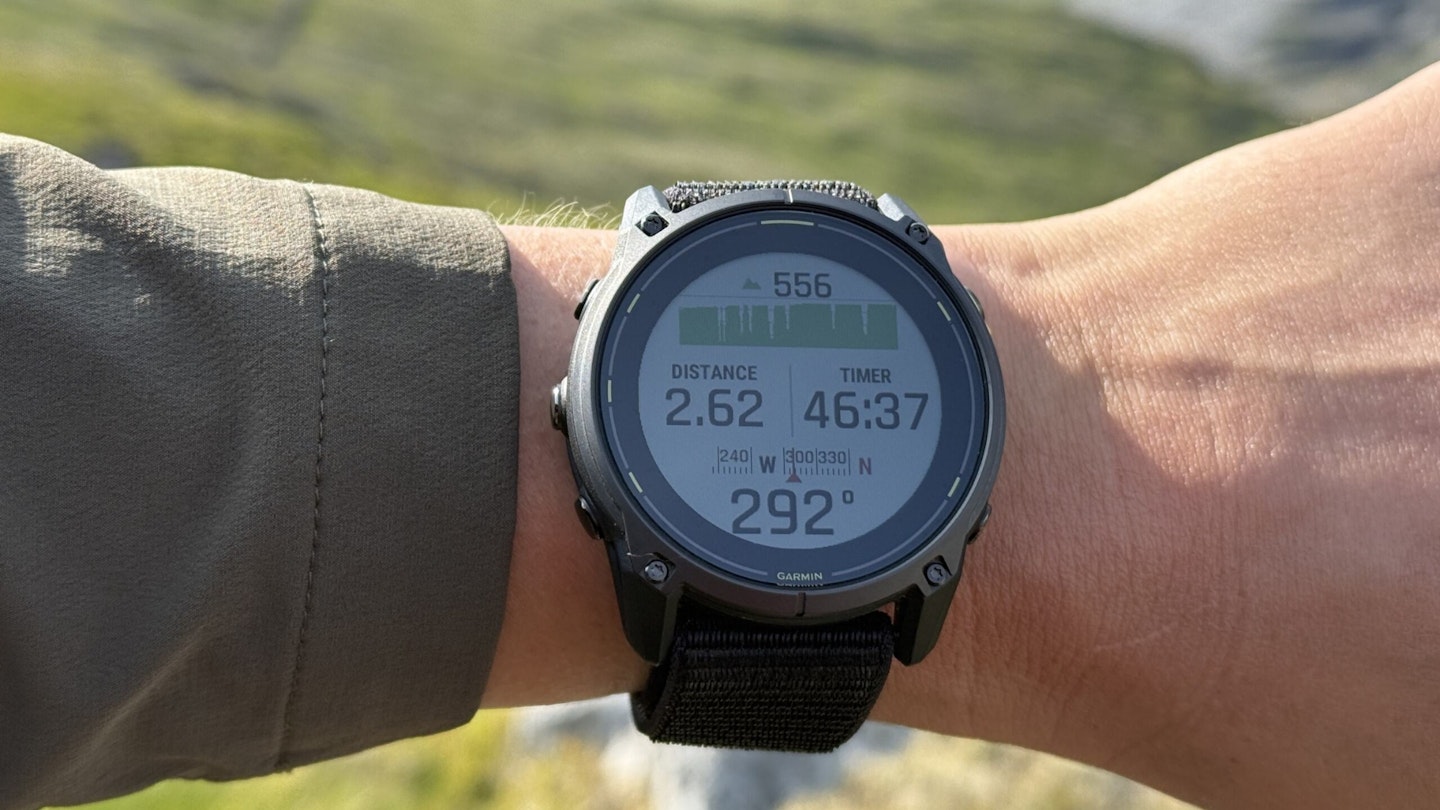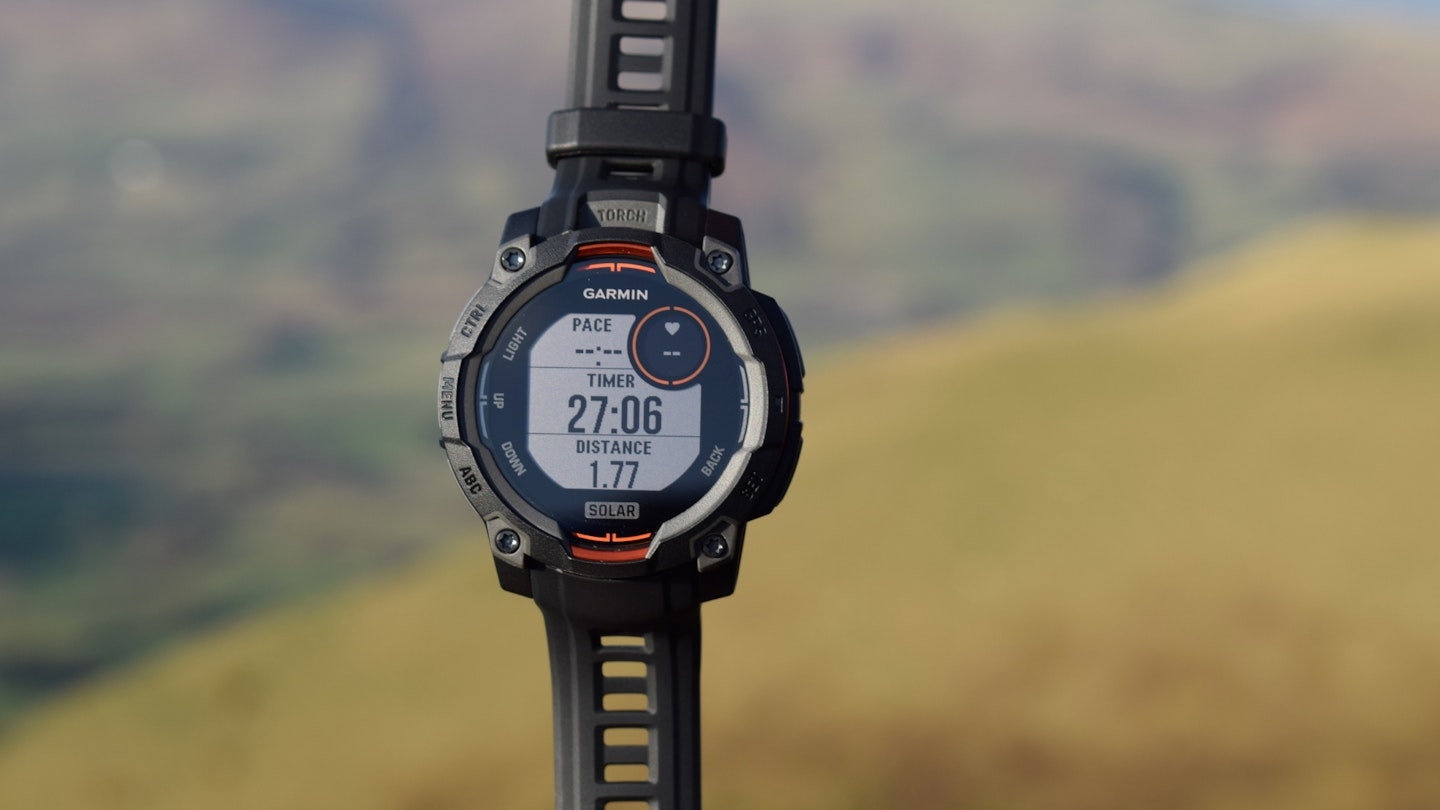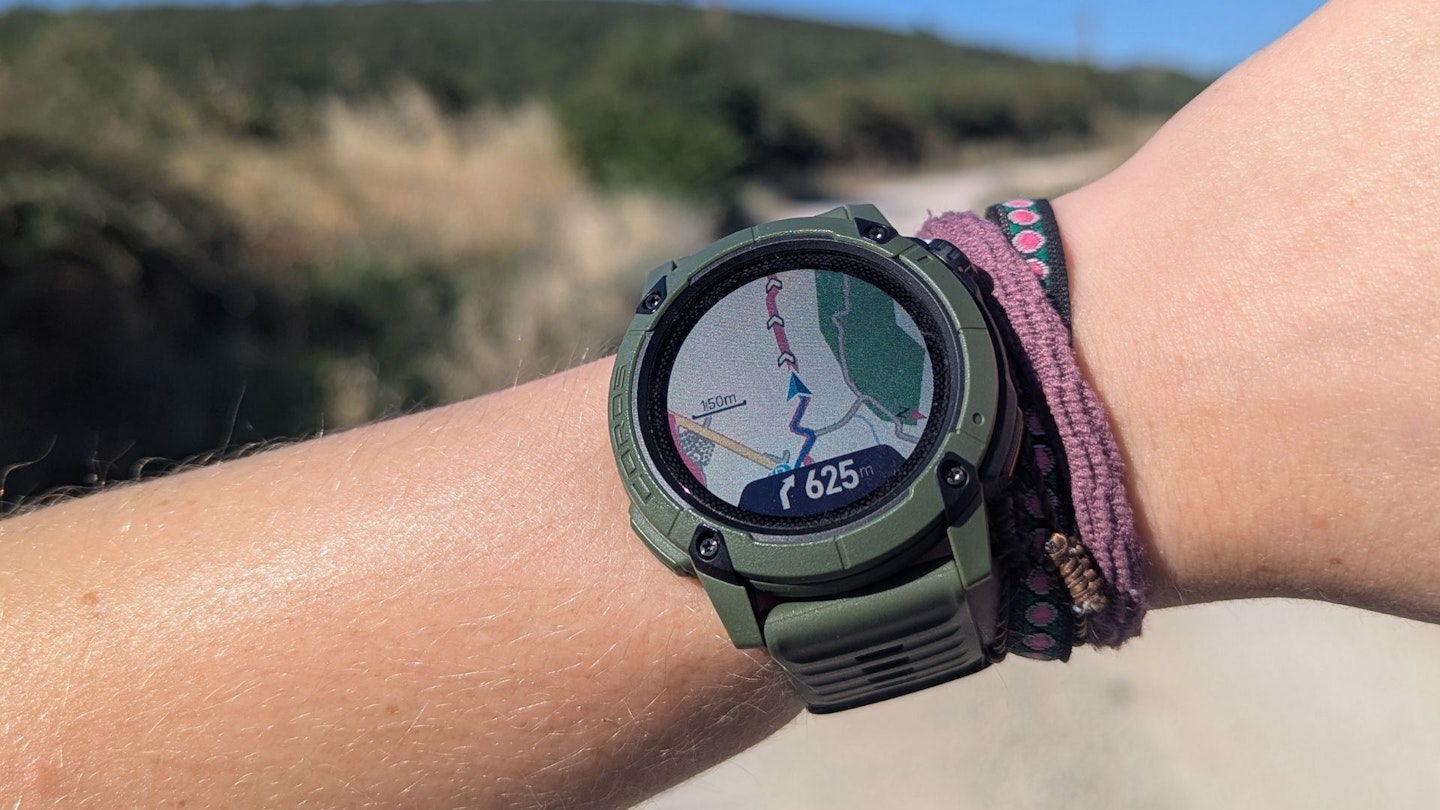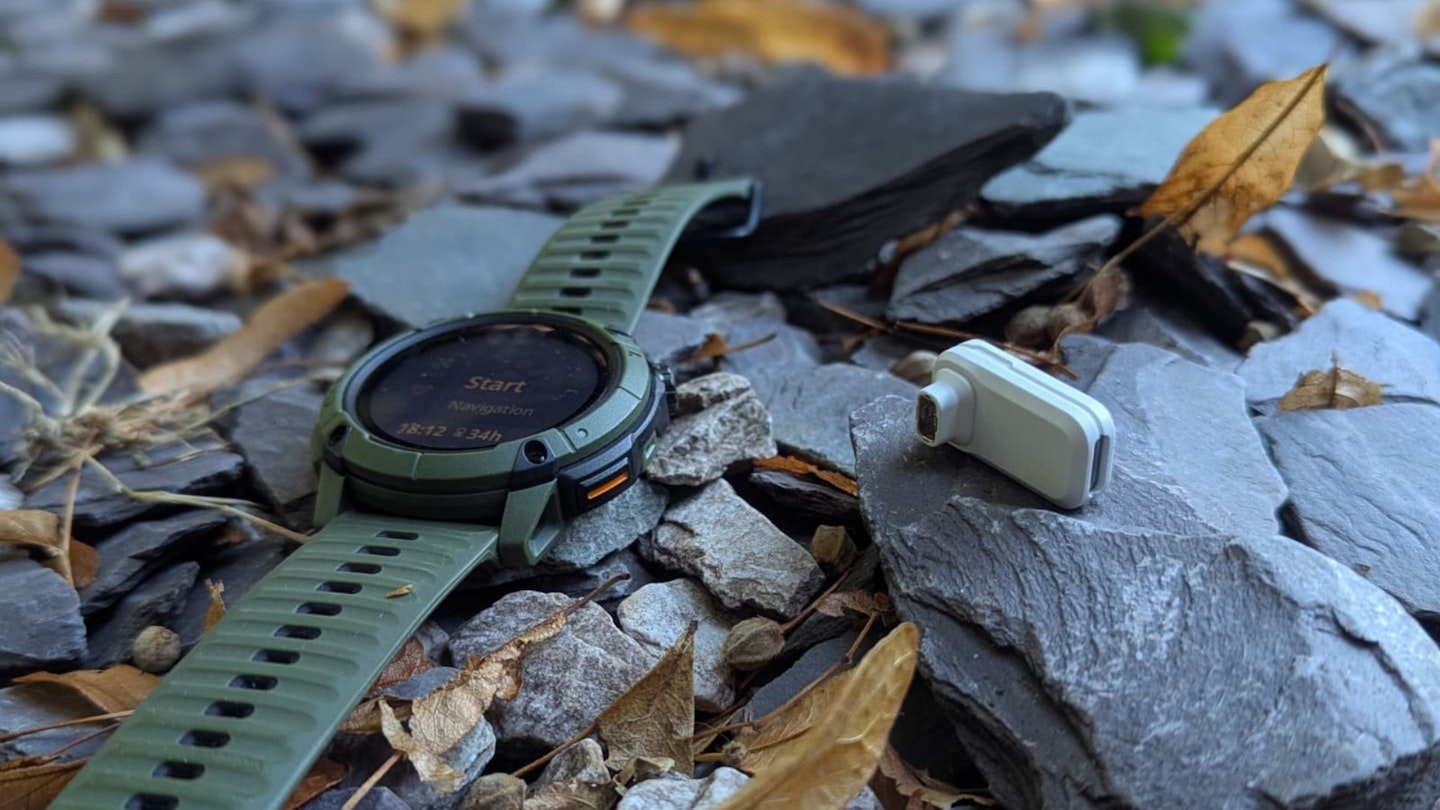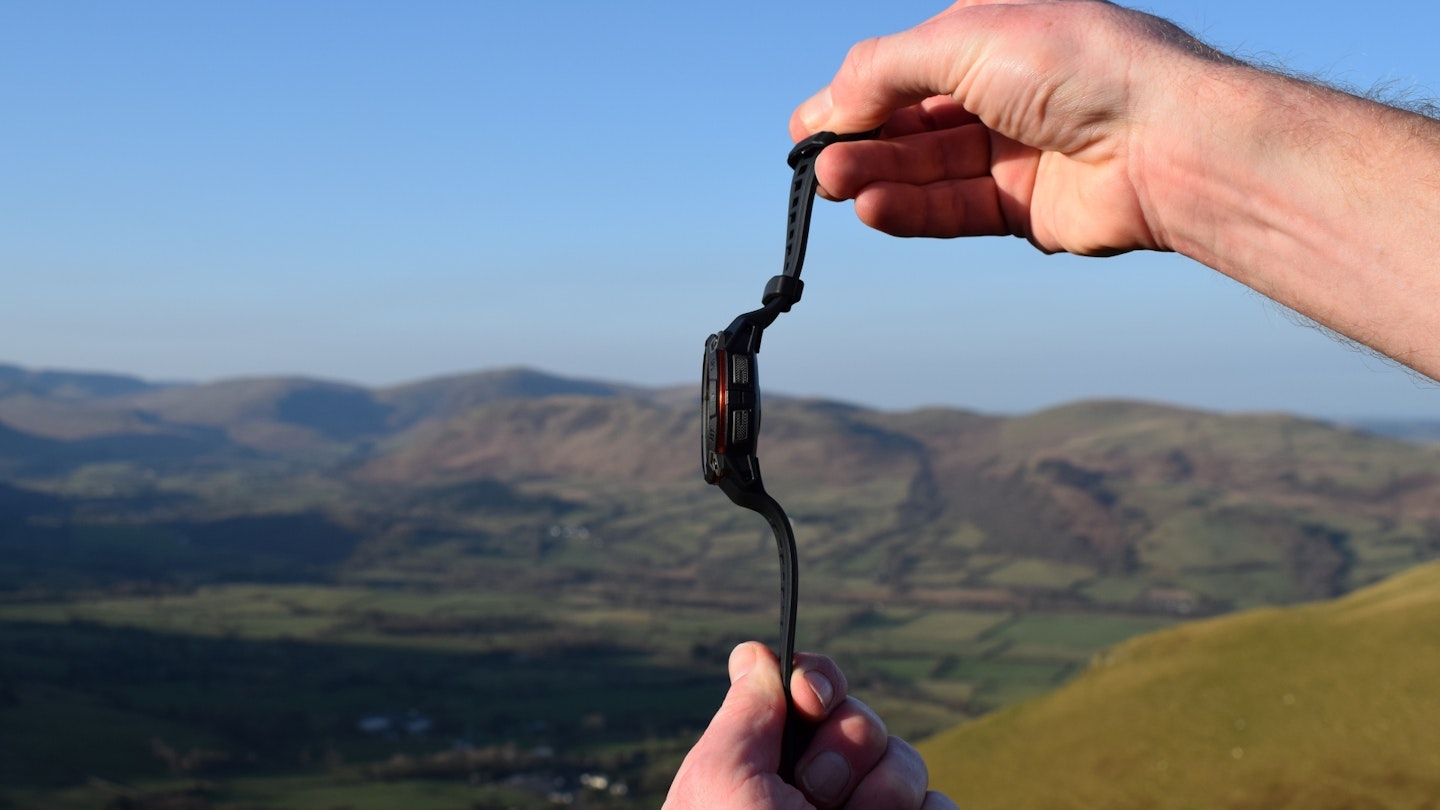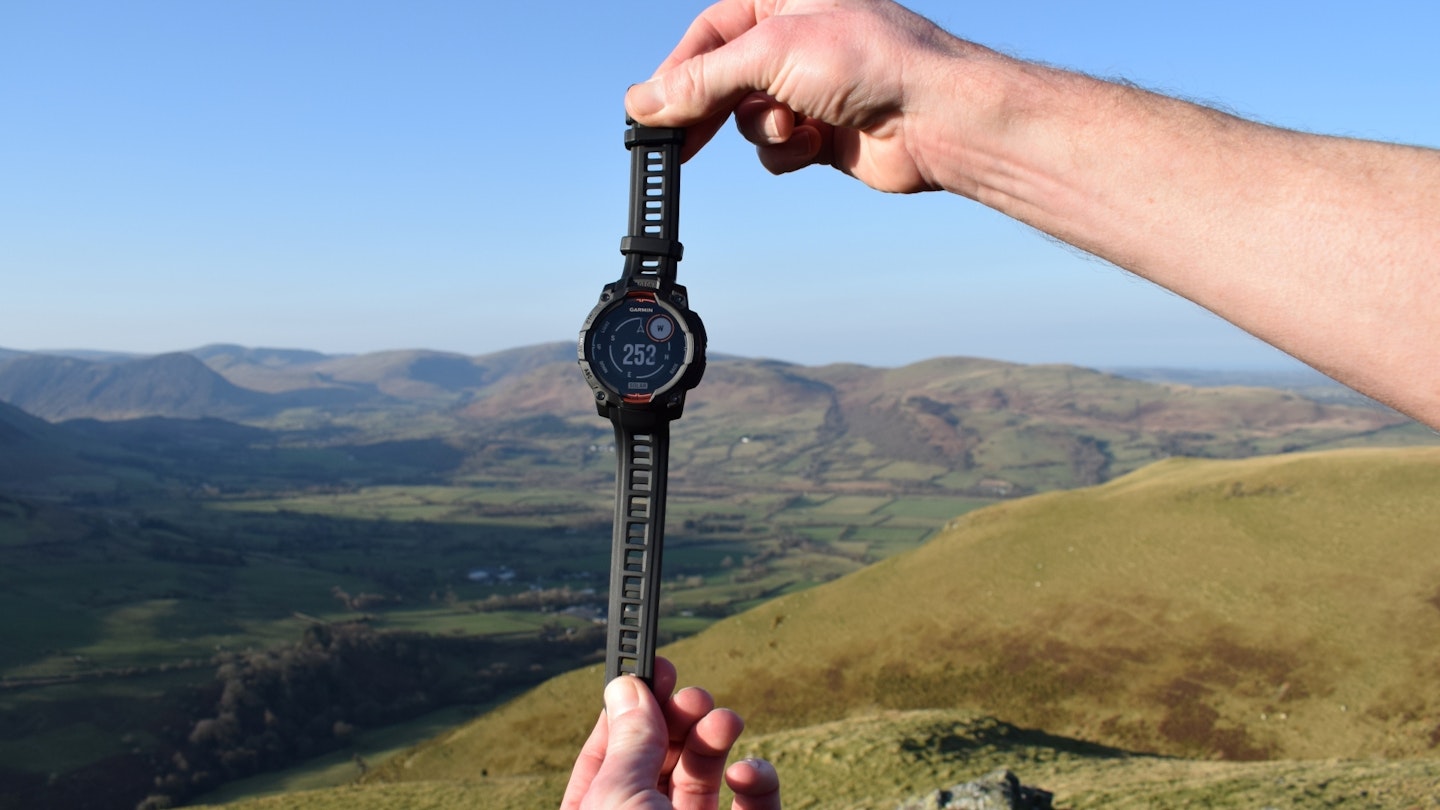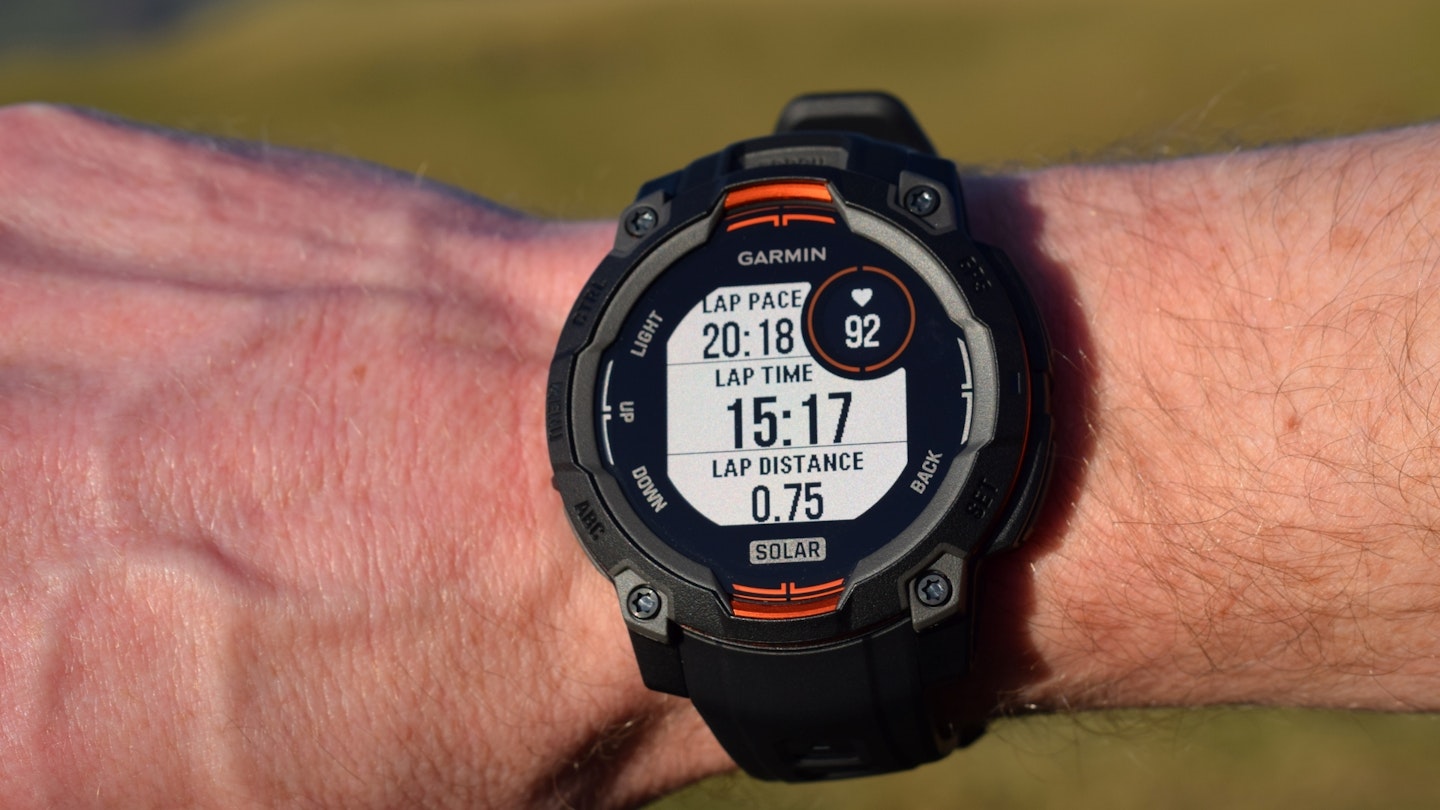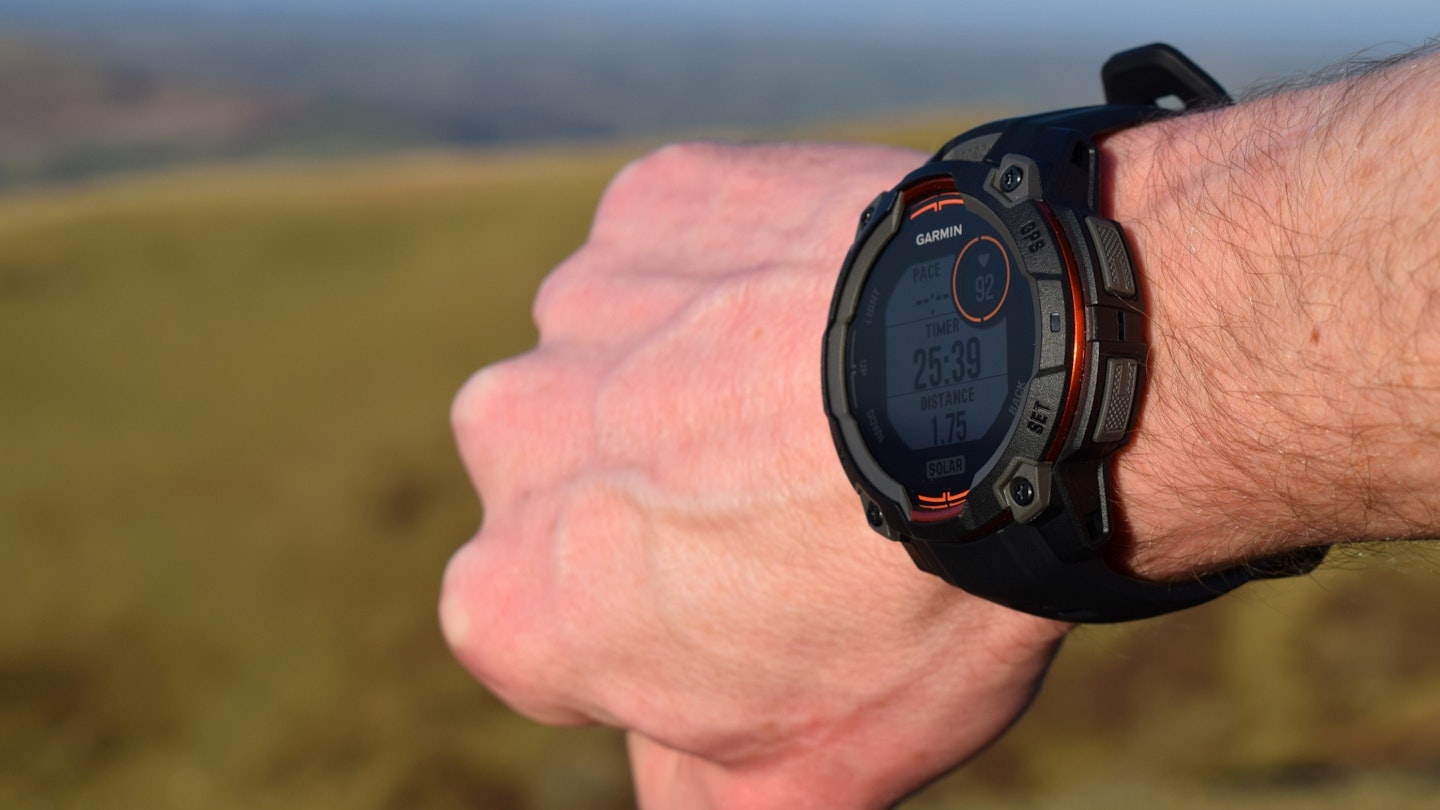At first glance, an outdoor watch might feel like a luxury. After all, your phone can tell the time and show a map, right? But in the hills, that’s rarely enough. Phones run out of battery, break easily and don’t sit ready on your wrist when you need quick info. An outdoor watch solves all of that.
The right GPS model keeps your essentials a glance away: time, altitude, distance covered, how long until sunset. Many also log your route, track your pace and even give you a grid reference when you’re not sure exactly where you are. That’s not just convenient — it’s a genuine safety net when conditions turn.
There’s also the durability factor. Outdoor watches, even those without GPS, are built tough: waterproof, shockproof and designed to take a beating, whether that’s scrambling over rock or days of rain. Where a standard watch or smartwatch might fail, a proper outdoor model keeps going.
And beyond pure function, there’s motivation. Like a running watch, some outdoor watches double as fitness trackers, nudging you to push further or recover properly. Others keep it simple, but still add confidence by stripping away the guesswork on long days.
In short: an outdoor watch isn’t just about telling the time. It’s one of the most useful walking accessories there is, helping you to stay safe, make better decisions and enjoy your time in the hills.
Best outdoor watches at a glance
Best outdoor watch overall: Suunto Race
Best budget GPS watch: Coros Nomad
Best Garmin watch for hiking: Garmin Fenix 7 Pro Solar
Best outdoor watch for battery life: Garmin Enduro 3
How we tested

At Live for the Outdoors, we don’t just copy specs from product pages. The kit we recommend has to earn its place in the hills. Testing matters because the difference between “good on paper” and “good in the wild” can be huge – and we want our readers to know which products genuinely deliver when it’s cold, wet and miles from the car.
The watches featured here were all tested by LFTO’s gear experts — experienced hikers, mountaineers and outdoor writers who regularly spend long days in the UK hills and beyond. Our testers included expert outdoor writers James Forrest and Matt Jones, plus group editor Oli Reed and freelancer gear reviewer Kate Milsom. Each watch was tested over a wide range of distances and terrains.
To keep things fair, we aimed to be as objective as possible. Every watch was judged against the same core criteria: performance in real conditions, the features on offer and how useful they actually felt, battery life compared with the claims on the spec sheet, overall usability including comfort, menus and ease of use and finally value — whether the watch genuinely delivered enough for its price.
For more info, read all about how we test gear.
Best outdoor watches of 2025
We wanted to ensure a range of different watches made our shortlist in order to cater to peoples' varying requirements. So, whether you need a watch that's great value, super rugged, or packed with as many sports and features as possible, there is an option here.
I put the Suunto Race to the ultimate test: a non-stop 28-hour, 111-mile run along the Cleveland Way. Through moorland, hills, dense forest and coastal paths, it tracked every step with near-perfect accuracy.
Even after nearly 30 hours of non-stop use, 65% of the battery remained – a testament to its “Ultra” GPS mode and endurance-focused design.
The large 1.43in AMOLED screen impressed me throughout my ultra run – it's crisp and bright enough to read in all conditions, making route-following and stats-checking effortless. Navigation via GPX tracks was straightforward, with turn-by-turn notifications and a reliable 'find back' function, which returns to your start point.
Its stainless steel case and chunky 13.3mm depth mean the watch feels weighty on the wrist, and dynamic runners might notice a bit of bounce. There are two main omissions – you can’t download music directly to the Suunto Race and the watch doesn’t support contactless payments.
Overall, this watch shines for anyone chasing ultra-endurance or multi-day challenges, offering top-tier battery life and GPS precision at a surprisingly reasonable price.
Read our full Suunto Race review for more.
Pros
- Superb AMOLED screen
- Excellent battery life
- Impressive price
- GPS accuracy
Cons
- Heavy
- Thick and chunky on the wrist
- No onboard music
- No contactless payments
| Weight: | 83g |
| Battery life: | Up to 50 hours (performance mode) or 200 hours (tour mode). Or 26 whole days without GPS or heart rate. |
| Waterproof: | 10ATM |
| Materials: | Stainless Steel |
| Screen size: | AMOLED, 466x466 resolution, 1.43” |
Launched in August 2025, the Coros Nomad is a versatile outdoor watch designed for adventure lovers, especially those who enjoy hiking, running and fishing.
It comes with a bright, 1.3in memory-in-pixel touchscreen that’s easy to read outdoors (it’s trumped by AMOLED screens, though) and helps deliver a very good battery life (albeit not class leading).
This equates to up to three weeks of daily use or 50hrs in all-systems GPS mode (34hrs with multi-band GPS).
Navigation is a highlight, with clear turn-by-turn colour maps, waypoint marking and a handy back-to-start function. However, the navigation prompts do block the zoom function when they pop up.
The Nomad also offers customisable activity profiles, accurate GPS and quick syncing with the decent Coros app for in-depth data analysis.
There’s a built-in microphone for recording and pinning voice notes during activities, letting you log memories and key locations along your journey. Though, how useful this is will depend on the individual.
It’s lightweight (61g), durable and water-resistant, with a robust build and handy physical buttons for sweaty workouts, though it doesn’t look the most premium compared to some competitors.
The Nomad tracks all the usual metrics, including heart rate, sleep, heart rate variability, training load and more.
At £319, it’s excellent value for those wanting a reliable, feature-rich adventure watch with journaling tools.
See our full Coros Nomad review for more.
Pros
- Impressive navigation functionality
- MIP screen is sharp and clear
- Battery life is very decent
- Clear audio recording
Cons
- Watch doesn't look particularly premium
| RRP: | £319/$349 |
| Weight: | 61g with silicone band; 49g with nylon band |
| Battery life: | 22 days daily use with sleep, daily stress, HR measurements; 50hrs all systems GPS; 34hrs dual frequency + all systems GPS |
| Storage: | 32GB |
| Materials: | Polymer and aluminium alloy bezel and backing; hardened mineral glass screen; silicone or nylon band |
| Display type and size: | MiP touch screen, 260px by 260px, 33mm (1.3in) |
| Waterproof rating: | 5ATM (50m) |
The Garmin Fenix 7 Pro is a top-tier outdoor watch packed with features for serious runners and hikers. It comes with a rugged build, reliable GPS and excellent battery life, lasting up to 40hrs in all-systems GPS mode (23hrs with dual-band GPS), or even longer with solar charging.
It's tough enough for camping or scrambling (especially if you buy the Sapphire version) and it’s water-resistant to 100m, so it’s perfectly happy when you’re swimming or hiking in heavy rain.
Navigation is very good, with easy-to-use, pre-loaded colour maps and accurate GPS tracking using multiple satellite systems. It’s easy to import GPX files or routes from other apps, while you can also create a route in the Garmin Connect app.
The watch is loaded with performance metrics, from heart rate to VO2 max, and offers advanced tools like Hill Score, Endurance Score and PacePro for training. You’ll also find extras like Garmin Pay, music storage and even a built-in torch (which is actually handy).
However, the Fenix 7 Pro is a chunky option (75g) that may not suit every wrist. The screen, while clear and readable, isn’t as sharp or bright as AMOLED displays on some rivals.
With an original RRP of £749.99 it’s expensive (though it costs less now) and may be more watch than casual users need.
Still, if you want a durable, feature-rich GPS watch for big adventures, the Fenix 7 Pro is hard to beat.
Find out more in our full Garmin Fenix 7 Pro Sapphire Solar review.
Pros
- Excellent mapping
- Solid battery life
- All-round performance
- Premium design
- Impressive build quality
Cons
- Very expensive
- Underwhelming screen for the price
- Slightly heavy, chunky shape
| Weight | 75g |
| Battery life | Up to 57 hours |
| Waterproof | 10ATM |
| Materials | Power sapphire |
| Screen size | 260 x 260 pixels, 1.3” |
When we first strapped on the Garmin Enduro 3, its size made us raise an eyebrow – 51mm across, 15.7mm thick, and 63g on the wrist isn’t subtle. But once we started testing, its strengths quickly won us over.
The standout feature is, without doubt, battery life: even pushing multi-band GPS for long hikes, it clocks up to 60 hours between charges, easily stretchable with solar exposure. In smartwatch mode, it lasts over a month.
Navigation is another strong suit. Following GPX routes via Garmin Connect or Komoot felt intuitive, and the full-colour topo maps gave a clear picture of the trails, rivers and villages around us. The multi-band GNSS kept our tracks precise, even in challenging environments.
On the trail, the Enduro 3 is reassuringly rugged. The reinforced case handled knocks and scrapes with ease, and the LED flashlight came in surprisingly handy when setting up camp after dark. The nylon-velcro strap was soft, quick-drying and stayed secure through every run and swim test.
The downside? The MiP display, while energy-efficient, isn’t as sharp or vibrant as AMOLED alternatives, and the menus can feel overwhelming at first. It’s also a chunky watch for trail running, but for long off-grid adventures it’s hard to beat.
Read our full Garmin Enduro 3 review for more.
Pros
- Exceptional battery life plus solar charging
- Robust build with titanium bezel, sapphire crystal and 100m/10 ATM water resistance
- Dedicated LED flashlight
- Excellent full-colour mapping with contour shading
Cons
- Expensive
- Array of features and functionality will be overkill for some
- Large case feels bulky, especially when running
- Pixel-based display isn't as crisp, clear or bright as AMOLED screens
| RRP: | £769/$899 |
| Battery life (GPS): | All Satellite Systems + Multi-band: Up to 60 hours/90 hours with solar; All Satellite Systems: Up to 80 hours/144 hours with solar; GPS Only: Up to 120 hours/320 hours with solar; Max Battery GPS: Up to 210 hours/unlimited with solar; Expedition GPS: Up to 77 days/unlimited days with solar* |
| Display type and size: | MIP, 280 x 280px resolution, 35.5mm |
| Case diameter: | 51mm |
| Weight: | 63g/2.2oz (with Velcro nylon strap) |
| Waterproof rating: | 10 ATM/100m |
| Battery life (smartwatch mode): | Up to 36 days/90 days with solar; Battery Saver Watch Mode: Up to 92 days/potentially unlimited with solar |
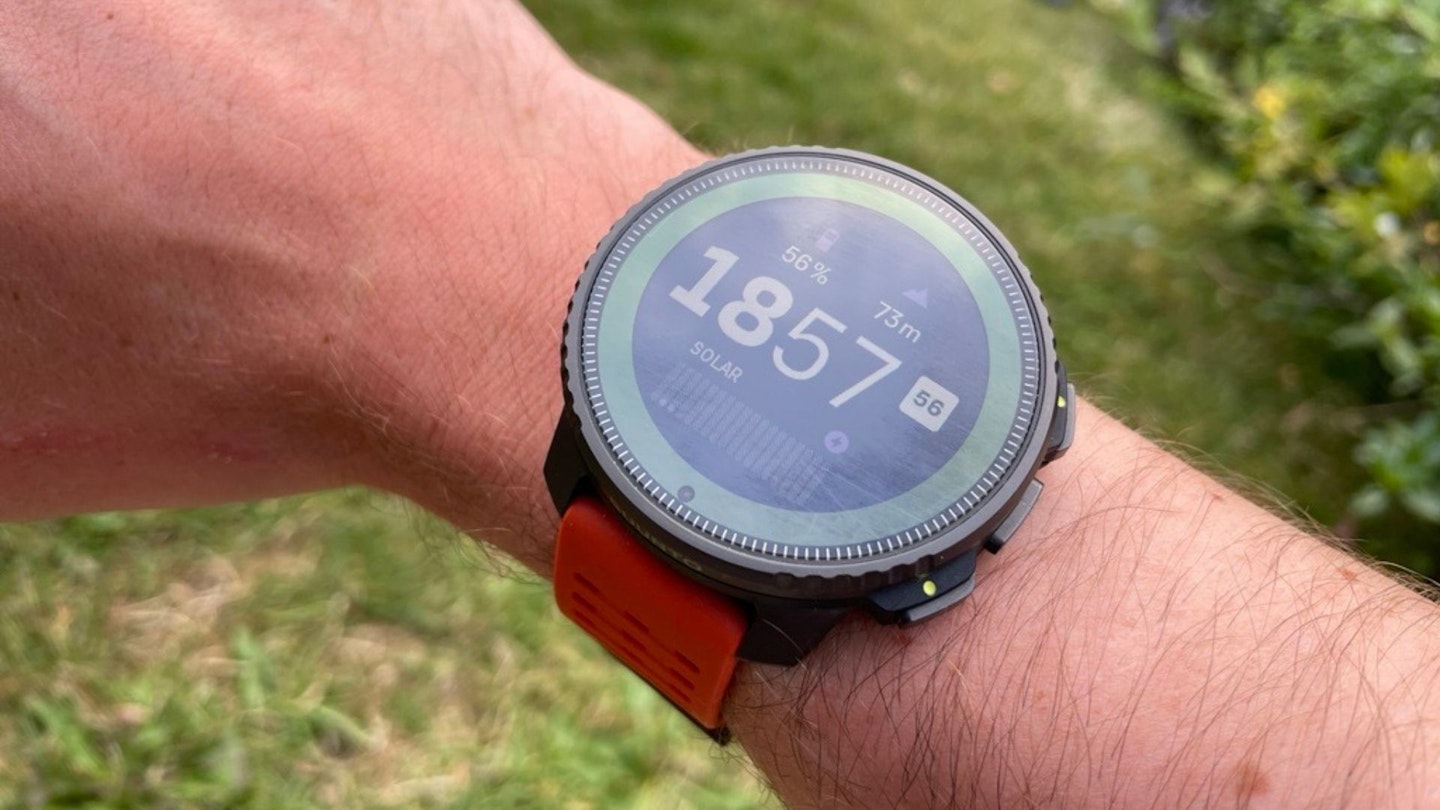 LFTO/Rob Slade
LFTO/Rob SladeOur testers loved this watch so much that we just had to sneak it onto this list as a second Suunto offering. The Vertical smartwatch marks an impressive leap for the Finnish brand as they've refined their interface to a super intuitive and accessible level.
A responsive (and tough) touchscreen combines with three side buttons for a simple set-up. Move up and down and select with the buttons; drag maps around, adjust music volumes, and deal with text messages by tapping the screen. Easy as pie. Though it can take a while to scroll through the 97(!) pre-set sport modes with additional customisation options.
The construction of the Vertical is excellent and durable, though this does give it a little heft. Both versions come with sapphire glass, which can bang, scrape or crunch against dense gabbro and still look like it’s ready for Oscar night.
With military-grade testing and waterproofing down to 100m, this watch can accompany you on some seriously hardcore adventures.
Read our full Suunto Vertical Titanium Solar watch review.
Pros
- Looks better than rivals
- Very impressive battery life
- Fast GPS location
- Solar and standard versions
- Excellent app
Cons
- Main display not as large or clear as rivals
- Interface isn't as good as rivals
| RRP: | £625/$699 |
| Battery life: | 60 days Solar, 30 days non-Solar (24/7 tracking and mobile notifications) |
| Waterproof: | Yes, 10ATM |
| Materials: | Titanium or stainless steel bezel, sapphire crystal glass |
| Screen size: | 49mm |
| Weight: | 74g/2.6oz (86g/3oz stainless steel version) |
 LFTO
LFTOAt £599, the Coros Vertix 2 S may undercut comparable Garmin watches, yet it still offers a tough titanium bezel, sapphire glass, and a large 1.4in touchscreen.
The MIP display isn’t as bright or sharp as AMOLED screens so it can be hard to read in bright sunlight, but this helps the Vertix 2S deliver excellent battery life – up to 36 days in smartwatch mode, 73hrs in all-systems GPS mode or 43 hours with dual-frequency GPS.
GPS accuracy is very good, thanks to a new antenna design and support for all major satellite systems. The watch is rugged and water-resistant to 100m, but it’s heavy (88g with silicone strap) and chunky, which may not suit everyone.
You get plenty of features: reliable mapping and navigation, a wide range of activity modes, sleep and wellness tracking, and strong training tools, while the Coros app is easy to use.
Like many watches, the heart rate sensor is decent but doesn’t match up to a chest strap. There’s no contactless payment or music streaming, though you can store MP3s.
If you want a durable, feature-rich watch with very good battery life without paying Garmin prices, the Vertix 2S is a solid choice.
Pros
- Superb price for a titanium watch
- Exceptional battery life
- Accurate GPS tracking
- Solid all-round performance
Cons
- Quite heavy (for a running watch)
- Chunky design
- Screen can be hard to read in high sunlight
| Battery life (smartwatch mode) | Up to 40 days |
| Battery life (GPS) | Up to 118 hours |
| Display type and size | Sapphire glass, 280 x 280 resolution, 1.4" |
| Weight | 88g (with silicone band), 70g (with nylon band) |
| Waterproof rating | 10ATM |
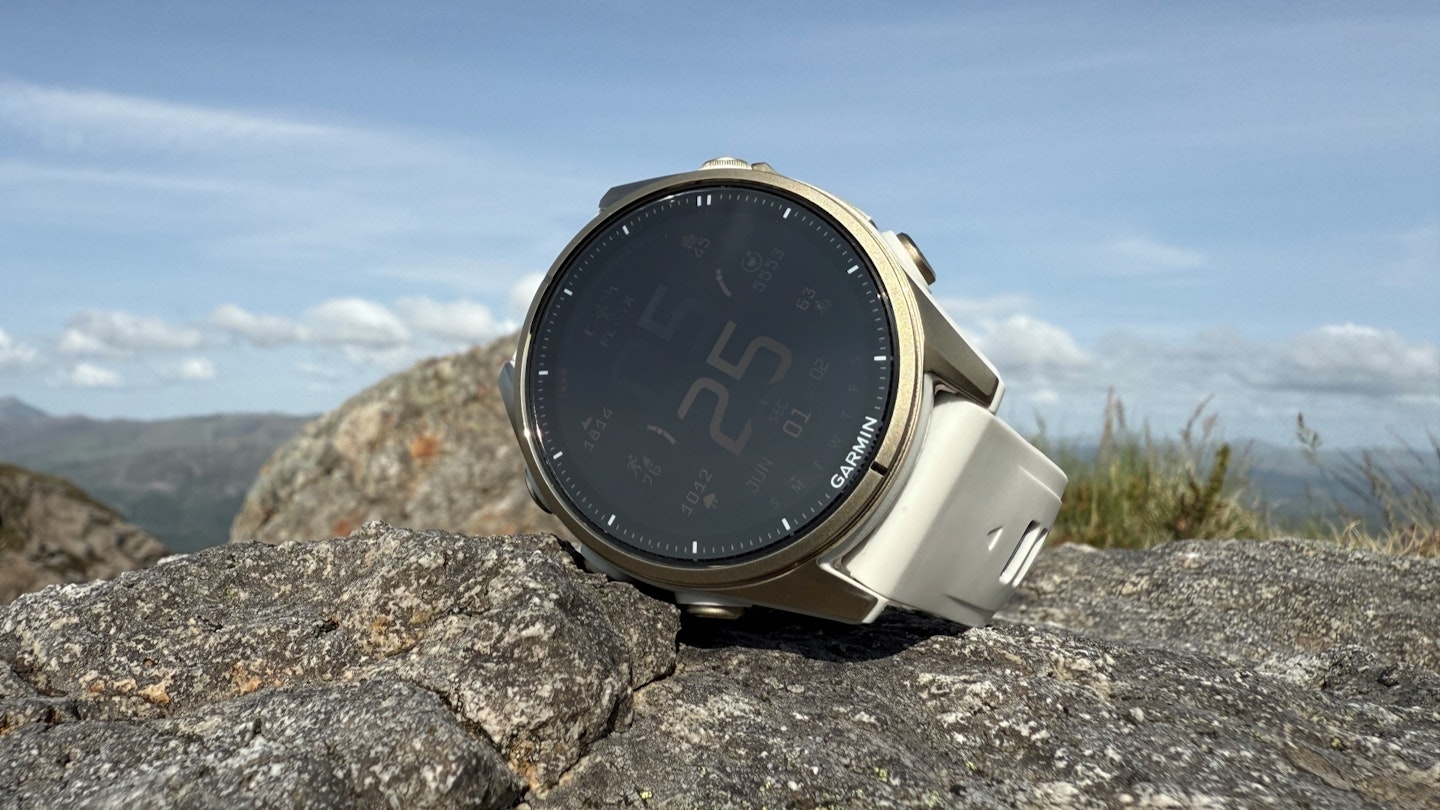 LFTO/Matt Jones
LFTO/Matt JonesThe Garmin Fenix 8 AMOLED is seen as the crème de la crème of GPS outdoor watches, and we can see why.
What are the differences with the Fenix 7? Well, the 8 brings a crisp AMOLED display, a microphone and speaker for wrist-based calls and voice commands, a handy LED flashlight and increased display size on smaller models. Diving functions, including a depth gauge, are new too.
When we tested the smallest version in the Snowdonia National Park, we found that navigation was effortless. GPX tracks sync from hiking apps like Komoot or can be imported, and multi-band GNSS kept positioning precise across moorland, forest and urban terrain.
The battery life on this 43mm model is adequate for day trips, but shorter than the solar-powered Fenix 7 options, the larger Fenix 8 AMOLED options or the Fenix 8 Solar version, which uses a MIP display.
Even for a GPS watch, the price is very steep – it's only really worth it if you demand the best of the best technology and can justify the investment. It's worth noting that capable alternatives exist at half the price.
Read our full Garmin Fenix 8 AMOLED 43mm review.
Pros
- Crisp, clear and bright AMOLED screen readable in all light conditions
- Built-in microphone and speaker for calls and voice commands
- Dedicated LED flashlight that's surprisingly useful
- Excellent full-colour mapping with detailed topographical data
- Comprehensive feature set with over 100 activity profiles
- Premium build quality with titanium options
Cons
- Extremely expensive starting at £880
- Complex interface overwhelming for newcomers
- Shorter battery life than solar alternatives
- Feature overkill for casual users
- Risk of damage anxiety given the investment
| RRP: | £879.99/$1,099.99 |
| Variants: | 43mm, 47mm, 51mm (plus solar options for two larger sizes) |
| Battery life (smartwatch mode): | Up to 10 days (43mm), 16 days (47mm), 29 days (51mm) |
| Battery life (All Systems GPS): | Up to 23 hours (43mm), 38 hours (47mm), 68 hours (51mm) |
| Display type and size: | AMOLED, 416 x 416px resolution, 35.3mm (43mm case) |
| Weight: | 60g/2.1oz - 43mm version |
| Waterproof rating: | 10 ATM / 100m |
The Garmin Instinct 3 Solar builds on the foundation set by the Instinct 2 Solar, offering a robust, lightweight option for outdoor adventurers, priced at £349.99. It’s an ideal choice for anyone who needs a durable sports watch for outdoor activities, but its improvements set it apart from its predecessor in meaningful ways.
While the Instinct 2 Solar was already a solid all-rounder with good GPS accuracy and a rugged build, the Instinct 3 Solar brings several notable upgrades. First, the GPS performance has improved, now featuring multi-band GPS for better accuracy in challenging environments, compared to the more basic GPS, GLONASS, and Galileo setup on the Instinct 2.
This makes the Instinct 3 more reliable in dense forests or urban areas, addressing one of the key weaknesses of the Instinct 2
The design remains largely the same: the lightweight 52g frame is incredibly comfortable, and the 23mm monochrome screen is still basic, but more efficient.
However, the Instinct 3 Solar takes a significant step forward with solar charging, allowing for up to 50hrs of all-systems GPS use, which is a big leap from the 30hrs offered by the Instinct 2 in the same mode.
Despite these improvements, this version of the Instinct 3 still keeps things simple – there are no AMOLED displays (though an AMOLED version is available with a shorter battery life for £389.99) or high-end maps like those found on the Garmin Fenix 7 Pro or Polar Grit X2 Pro.
If you’re looking for premium navigation features or a more vivid display, those models may be a better fit.
However, for a rugged, lightweight and reliable GPS watch with decent battery life, the Instinct 3 Solar is a very good and more affordable choice, especially for users who loved the Instinct 2 but recognised its flaws.
Read our full Garmin Instinct 3 Solar review for more info.
Pros
- Well-priced
- Very robust and muscular, yet ultralight
- Simple but practical
- Versatile
- Good for multi-sports
- Dual-band GPS frequency
Cons
- No QZSS or Beidou
- No onboard music
- No topographical maps
- Screen doesn't support touch and is monochrome only
- Upgrades for Instinct 3 are not game-changing
| RRP: | £349.99 / $399.99 |
| Battery life (smartwatch mode): | Up to 28 days |
| Battery life (GPS): | 28-50 hours (all systems); 24-40 hours (multiband GPS) |
| Display type and size: | Power Glass, 176 x 176 resolution, 23mm (0.9”) |
| Weight: | 52g / 1.8oz |
| Waterproof rating: | 10ATM |
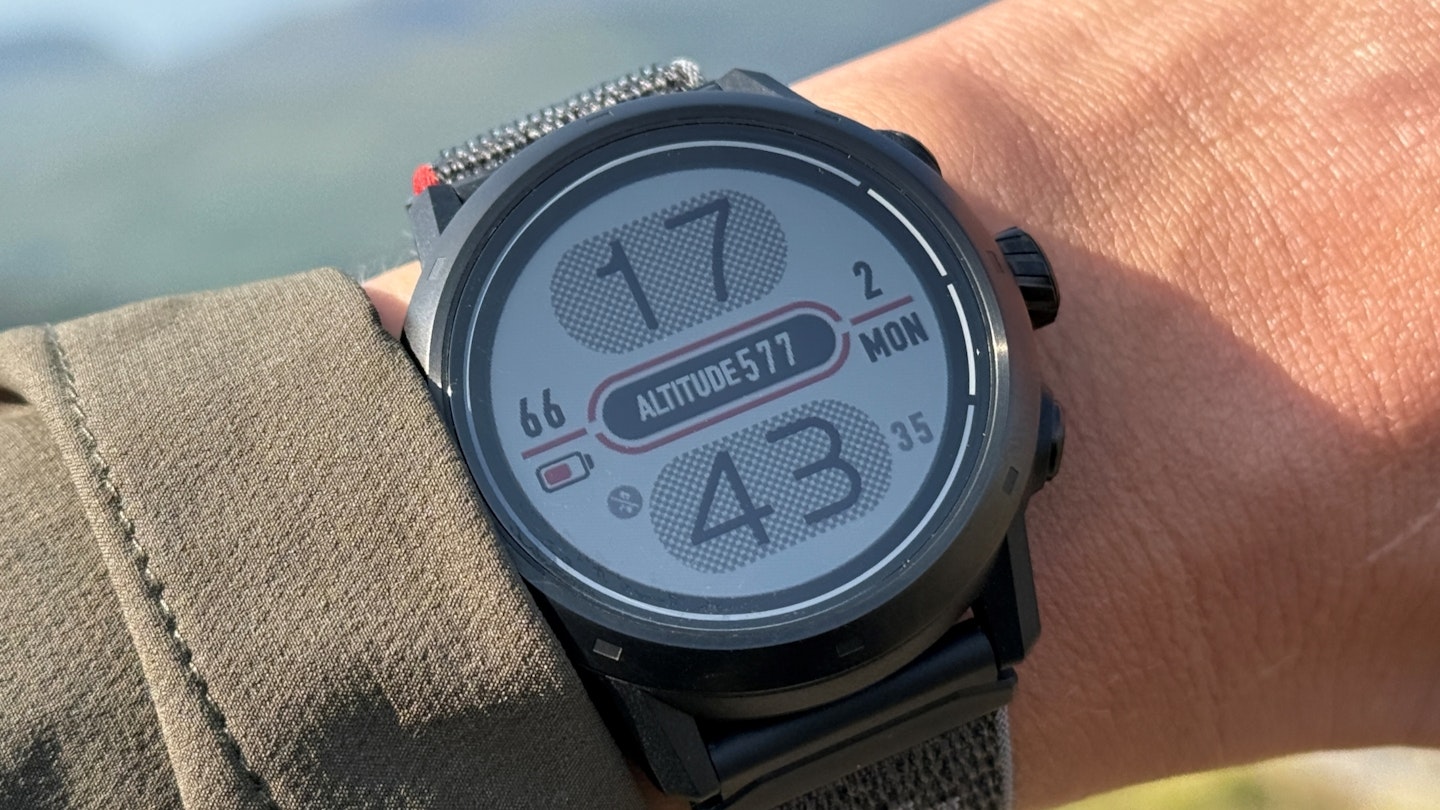 LFTO/Matt Jones
LFTO/Matt JonesOne of the first things that struck us about the Coros Apex 2 Pro is how little you have to charge it. This impressive GPS outdoor sports watch boasts 41hrs of battery life in all-systems GPS mode. We can confirm that we went more than three weeks before recharging, despite using it on plenty of local walks and runs and spending countless hours fiddling with its features.
Many outdoor enthusiasts look at Coros as a slightly more affordable alternative to Garmin. So while the Apex 2 Pro seems pricey, you get plenty for your money here.
Firstly it looks great with a lightweight and comfortable nylon strap, 1.3in sapphire glass screen, plus chunky buttons and a titanium dial you can operate using a pair of thin gloves.
In terms of functionality for hillwalking, the Coros 2’s redesigned dual GPS antenna feels reliable and the offline maps are decent (if not particularly detailed). It isn’t classed as fully waterproof but has been built to withstand water to 50m and temperatures ranging from -30°C to 50°C. So no worries there.
In terms of nice extra touches, you also get a touchscreen, MP3 music player, night mode, blood oxygen sensors and heart rate monitor, plus much more we haven’t discovered yet.
If you want a stronger endorsement than ours, this is also the watch brand of choice for mountain-running superman Kilian Jornet, so it must be doing something right!
Read our full Coros Apex 2 Pro review for more.
Pros
- Long battery life
- Genuine alternative to Garmin
Cons
- Others have better waterproof ratings
| RRP: | £449/$449 |
| Battery life: | 75 hours |
| Waterproof: | Water-resistant, 5ATM |
| Materials: | Nylon strap (silicone optional); sapphire glass; titanium alloy case |
| Screen size: | 33mm |
| Weight: | 53g / 1.9oz |
 Live For The Outdoors
Live For The Outdoorswww.suunto.com
Thinking that the 9 Peak Pro is too dainty and pretty to hold a candle to the others here is a mistake. There are two versions of it: the standard and the Titanium. The latter has a titanium bezel, compared to stainless steel on the standard version.
We’ve been testing the standard version, dropping it on trails and ‘accidentally’ grazing it against hard surfaces. The sapphire glass face hasn’t suffered a scratch.
Suunto has improved the interface of the 9 Peak Pro compared with the 9 Peak. Everything is much clearer in terms of display and menu organisation. We found that it still takes a few days of playing around with it to feel at home with the system, but it’s a big improvement.
Once you’re used to it, you can configure the interface as you please and your recently selected sports are always kept at the top of the sports menu.
However, we did find it takes a bit longer to sync with its app and to locate our position than the Garmin watches. But it's extremely accurate and the Suunto app is very good.
It opens onto your activity archive instead of irrelevant stats. You can therefore instantly look at the activities you’ve done.
You can also easily toggle between decent topographical mapping and satellite imagery and watch walk-throughs of your route to see your pace, altitude and heart rate as you walk.
Read our full Suunto 9 Peak Pro review for more.
Pros
- Excellent touchscreen
- Looks great
- Brilliant app
- Very accurate
Cons
- App syncing is slower than Garmin
| RRP: | £315 |
| Battery life: | 21 days (with 24/7 tracking and mobile notifications), 40 hours (all systems GPS) |
| Waterproof: | Yes, 10 ATM |
| Materials: | Silicone, textile, or microfibre strap; sapphire glass; fibreglass polyamide case |
| Screen size: | 30.5mm |
| Weight: | 64g |
 LFTO
LFTOThe Polar Grit X2 Pro is designed to be an outdoor watch suitable to a wide range of activities, with its rugged build a key plus. It makes use of a military-grade build, sapphire glass and a 10ATM water resistance rating, so it’s ready for harsh conditions and swimming.
One of the watch’s standout features is the large, bright 1.39in AMOLED touchscreen, which makes maps and stats easy to read even in bright sunlight.
The mapping and navigation are very good, with pre-installed maps for North America and Europe and clear route tracking. However, turn-by-turn prompts are only available for routes imported via Komoot, which isn’t exactly ideal.
GPS accuracy is very good, using all major satellite systems and dual-frequency tracking. Battery life is solid (up to 43 hours in full GPS mode), but not class-leading, especially if you use the always-on display.
On the downside, the watch isn’t exactly lightweight (79g) and can feel bulky on smaller wrists or during fast runs. It’s also expensive (and we’d say overpriced) at £649 and lacks onboard music storage and contactless payments.
Ultimately, it’s a decent all-rounder for outdoor enthusiasts who want a clear screen, good mapping and a tough design – as long as you can swallow the price and a few flaws.
Read our full Polar Grit X2 Pro review for more.
Pros
- Borderline indestructible design
- Superb AMOLED screen
- Excellent mapping
- Great waterproof rating
Cons
- Fairly chunky on the wrist
- No contactless payments or music storage
- Reliance on Komoot for turn-by-turn directions isn't ideal
| Battery life (smartwatch mode) | Up to 10 days |
| Battery life (GPS) | Up to 43 hours |
| Display type and size | AMOLED, 454 x 454 resolution, 1.39” |
| Weight | 79g (with silicone band) |
| Waterproof rating | 10ATM |
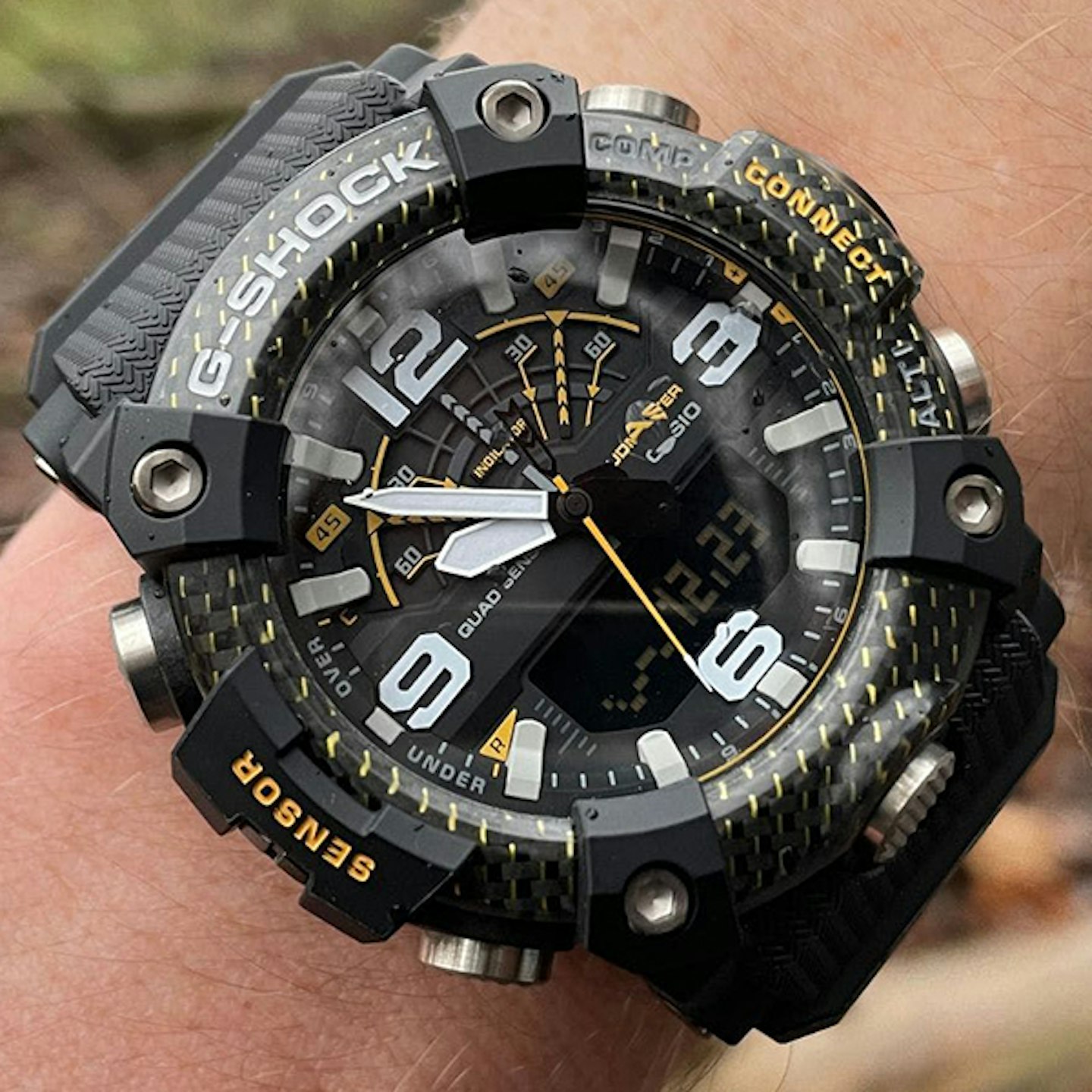
g-shock.co.uk
This Casio G-Shock watch is a uniquely rugged sports watch. Fans of the G-Shock range will know that in terms of styling, they have the opposite approach to the Suunto 9 Peak Pro. The GG-B100 is beefy and chunky and proudly so.
This watch doesn’t have a heart rate monitor or built-in sports apps like the others. Instead, it has a magnetic compass, altimeter, barometer, accelerometer, and gyrometer. It has a step counter and thermometer too. In terms of functionality then, it’s relatively straightforward. But you can still connect the GG-B100 to a smartphone via Bluetooth to record activity logs and adjust the watch. We find the app quite amusing. It has the appearance of a war strategy game and is easy to use but also quite basic.
Toughness is important here. The case looks like carbon fibre, and it says ‘Carbon Core Guard’ on the underside. It’s actually a carbon fibre-reinforced resin but is still mighty tough. The mineral glass is scratch-resistant and protected by the protruding bezel. The Casio is water-resistant down to 200m. In short, it’s the most rugged watch here.
This type of watch will suit some and not others. But what will appeal to all is the exquisite level to which it’s made and how incredibly comfortable it is to wear.
Read our full Casio G-Shock Mudmaster GG-B100 review for more.
Pros
- Very tough
- Very comfortable
- Buttons easy to use with gloves
Cons
- No solar option
- No sports apps
| Weight: | 92g |
| Battery life: | Approx 2 years |
| Waterproof: | Yes, 20 ATM |
| Materials: | Resin strap; mineral glass; carbon-reson case |
| Screen size: | 35mm |
Features to look for in an outdoors watch
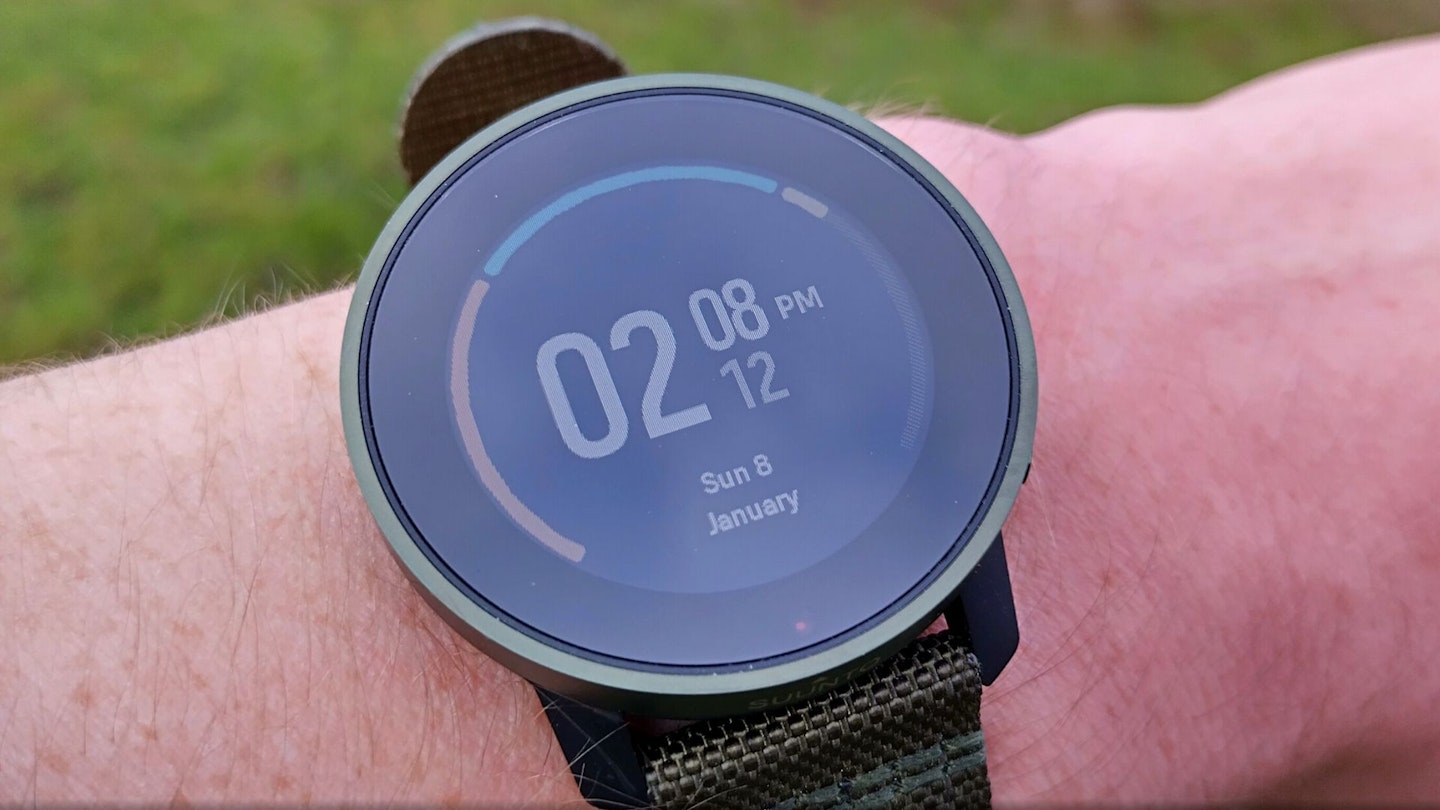
Size
Some smartwatches and hiking watches are particularly chunky, while others are more slimline. Many models are available in a range of sizes so you can choose what suits you, but be aware that smaller options typically sacrifice battery life.
Before buying, you should consider how the watch will sit on your wrist, particularly if you intend to use it as an everyday watch. And remember, the chunkier it is, the more likely it is to catch on things, such as clothing or rocks while you're scrambling.
Display
Larger watches pack in screen space, which can make it easier to read and consume the info on your watch, but the other big determiner is screen type.
Memory in pixel (MIP) screen can come with monochrome or colour displays and are typically duller than AMOLED screens. Legibility can vary between MIP displays, as can viewing angles and performance under direct sunlight.
AMOLED screens are generally always going to be more vibrant and easier to read, but legibility can also be impacted by how info is laid out. The downside of AMOLED screens is that they have a significant negative impact on battery life, particularly if you have your display set to 'always-on'.
Mapping and navigation
Most outdoor watches include some form of mapping and navigation these days. Cheaper options tend not to include detailed maps, but instead rely on what's called a breadcrumb trail. This means there'll be a line to follow on a blank screen, if you've imported a route.
If you've not done that, but are still tracking your activity, then there will be a line to show your progress so far, with a marker showing where you are. Even without a map in the background this can be useful, as it allows you to accurately retrace your steps in the event that you come unstuck.
At the higher end of the market watches will show detailed mapping on their screens. Although not great for route planning (even the largest watches have relatively small screens), this type of mapping can be a helpful extra navigational tool. This is particularly the case if the maps are detailed with road names, points of interests and contours.

Ideally, maps will be preloaded onto the watch or can be synced from the accompanying app. Some brands allow you to create routes in their app, which really should be standard these days.
How easy it is to import GPX routes is another key consideration, so keep an eye out for this. Integration with apps such as Komoot and Strava can help, but sometimes require a paid subscription for you to make use of it.
The gold standard is app integration, plus the option to import GPX routes and make use of turn-by-turn directions, but be aware that this is only possible for some devices if you're a paid user on one of these third party apps.
Battery life
Battery performance has increased dramatically over the past few years. Check the watch’s spec for battery life, paying attention to the times stated with GPS turned on, multi-band GPS turned on and any battery-saver modes that might reduce features.
What you need from a battery will really depend on how you plan to use it. If you're only ever going to be out for a day, you'll have plenty of options to choose from. But if you're a multi-day hiker then the longer the better.
You also need to check the detail, as things like AMOLED screens, always-on displays and music playback can dramatically cut battery life.
Sensors

In addition to GPS, these little watches can contain a range of sensors, including an altimeter, barometer, accelerometer, compass, heart rate monitor, blood oxygen and more. Make sure your choice has the sensors that are important to you.
If you want to make use of any of the training features on a watch, a reliable heart rate monitor is key, as this is the main aspect that feeds into what your watch is telling you.
Watches typically use an optical heart rate sensor and a process called photoplethysmography (PPG), which shines light through your skin to take readings. However, sweat, water, hair and freckles can all impact accuracy, while these type of monitors can also struggle with big changes in exercise intensity.
While none can currently compare in accuracy to chest-based heart rate monitors, many are now advanced enough that they deliver good performance for most users.
On many watches the heart rate monitor will also be used to provide you with a heart rate variability (HRV) score. This is measured every night and gives you a 'normal' range. If you fall out of that range, it can be a good measure of how unready your body is for exercise.
Fitness and sport features

Do you just want a watch that gives a grid reference or one that can also track your walks, runs, swims, or even your golf? Most outdoor watches now offer dozens of sport profiles, but the specifics and data on display varies.
We like to be able to see elevation profiles, data about speed and distance covered, distance remaining and more.
Training features also come in different shapes and sizes but how useful they are to you will depend on your preferred activities. If you train for your adventures, things like training load, training readiness and recovery times can be useful aids (though you normally need to take them with a pinch of salt).
Satellite compatibility
GPS is just one global satellite network (American). The four others are GLONASS (Russia), Galileo (Europe), QZSS (Japan), and BeiDou (China). The more your watch is compatible with, the more accurate it will be.
Many modern watches now also have multi-band or dual-frequency capabilities, which equal more accurate positioning and tracking, though this does come at the cost of battery life.
Of course, you can normally choose what GPS setting you want to use so you can balance your accuracy and battery needs.
Additional features
Spending time outdoors allows you to disconnect, but if you do like to stay connected you'll be thankful to smartphone notifications. These normally come as standard on GPS watches, though you can turn them off if you don't want to use them.
If you want smartwatch functionality as well as GPS features then you'll want to keep an eye out for the ability to make contactless payments via your watch, while music storage or streaming functionality with a phone can also be popular.
How to choose the best outdoors watch for you
Activity
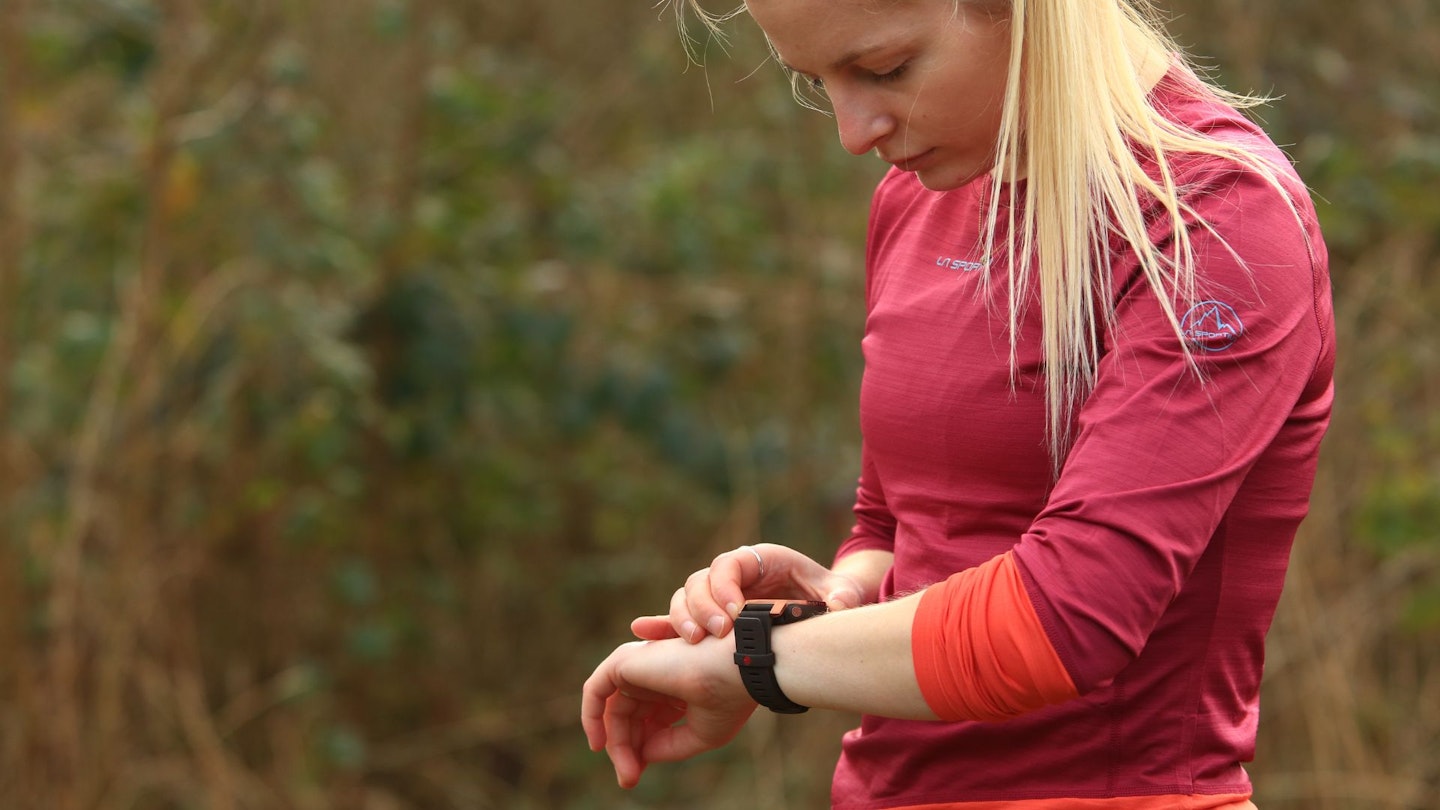
Start with what you’ll actually be doing. If you’re mainly walking day routes in the UK, you probably don’t need a top-end GPS powerhouse — a durable field watch or entry-level GPS model will cover the basics.
But if you’re into multi-day backpacking, mountain marathons or alpine objectives, features like accurate altimeters, detailed mapping, long battery life and reliable GPS become more helpful. Matching the watch to your activity means you’re not carrying (or paying for) stuff you’ll never use.
Smart features vs simplicity
Some hikers love data, notifications and training prompts; others just want the time and maybe a bearing. A smartwatch-style GPS watch can double as a fitness tracker, personal coach and navigation tool, but all that complexity can feel distracting if you just want to focus on the trail.
Field watches sit at the other end of the spectrum — no buzzing, just reliable time-telling. The best choice depends on whether you like being connected and analysed, or prefer a quieter, simpler approach.
Budget
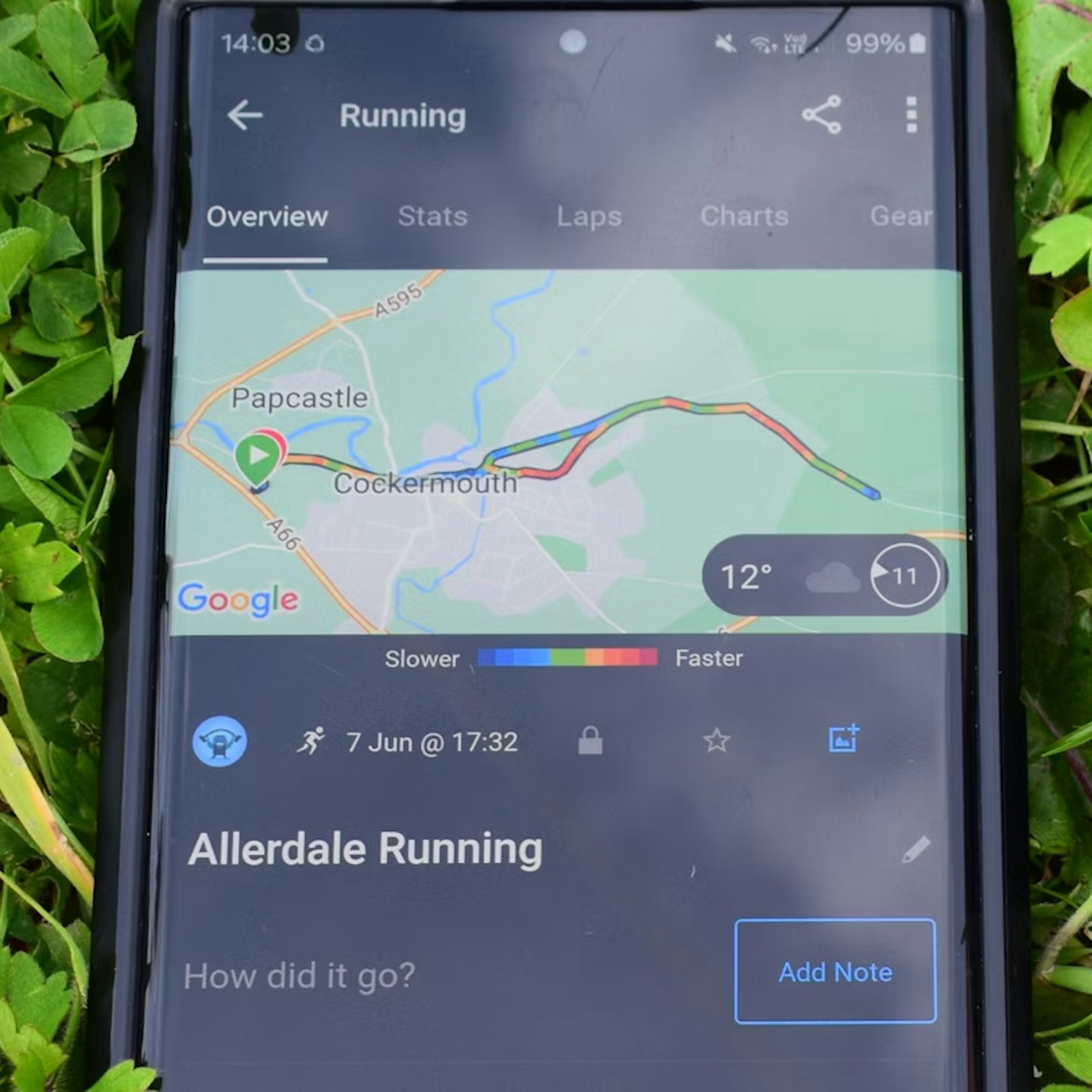
Outdoor watches range from under £100 to well over £800, so setting a budget upfront helps narrow the field. Spend less and you’ll get basic functions; spend more and you unlock mapping, solar charging and multi-sport tracking.
Our advice? A reliable, mid-range watch that does everything you need is a better investment than a flashy flagship you’ll barely scratch the surface of.
How to take care of your outdoor watch
Cleaning
After a muddy hike or salty coastal walk, give your watch a quick rinse in fresh water and wipe it down with a soft cloth. Sweat, sun cream and grit can build up over time, working into buttons. A regular clean keeps everything running smoothly.
Storage
If you’re not wearing it, store your watch somewhere cool and dry. Leaving it in a damp kit bag or baking on a car dashboard is a fast way to shorten its lifespan.
If you’re putting it away for weeks at a time, make sure it’s fully dry first. If your watch has a rechargeable lithium battery (most GPS and smartwatches do), it's best to top up the battery now and then to keep it healthy.
Strap maintenance
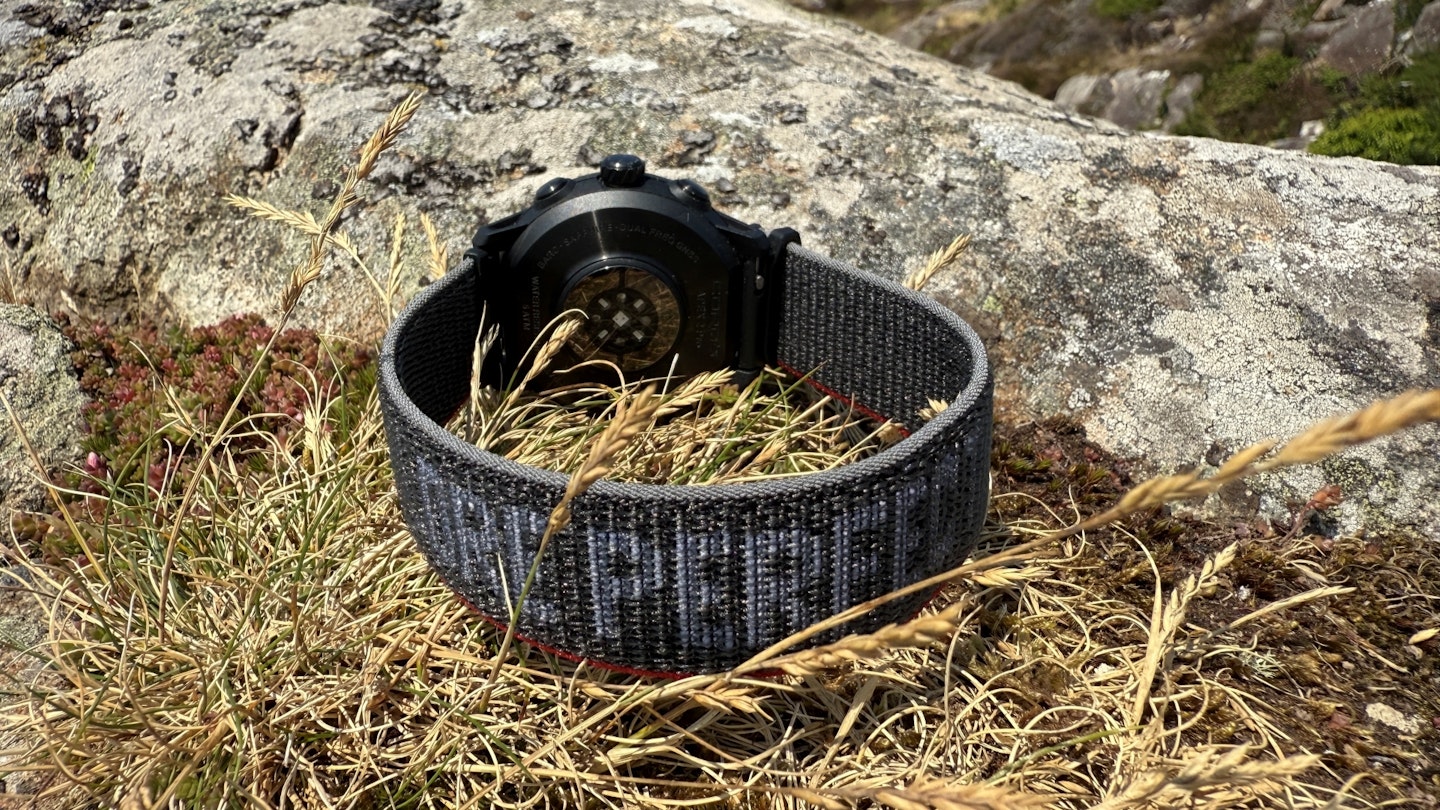
Straps take a lot of abuse – sweat, mud, UV, abrasion. Silicone bands can just be rinsed and dried, while leather needs a little more care (wipe it clean and avoid soaking it).
For fabric or nylon straps, a gentle hand wash works best. Checking for cracks or fraying every so often is worth it too; replacing a strap before it fails is far easier than watching your watch bounce down a scree slope.
Do I really need a GPS watch for hiking?
Not at all. A paper map, compass and the know-how to use them will always be the gold standard in the hills.
That said, a GPS watch can be a brilliant backup – it’ll log your route, give you at-a-glance grid refs and keep an eye on your pacing or altitude. We wouldn’t say you need one, but once you’ve used one it’s hard to give up the convenience.
What is the best watch for outdoors?
While we hand out awards for watches that are best in test (the Suunto Race) and best value (the Coros Nomad), there isn’t one single “best” as it really depends what you want from it. If you’re mainly walking trails, a mid-range GPS watch with mapping and decent battery life is ideal.
If you’re into ultra-distance stuff or multi-day trips, look for something with solar charging and week-long stamina (such as the Garmin Enduro 3 or Suunto Vertical). And if navigation is your weak spot, get a watch with proper topo maps rather than breadcrumb trails.
Are Garmin watches good for hiking?
Yes – Garmin has pretty much set the benchmark for outdoor GPS watches. We've tested a whole bunch of Garmins, and we can tell you that their Instinct range is bombproof – for example, see our reviews of the Garmin Instinct 2 and Garmin Instinct 3.
The Garmin Fenix 7 is packed with features, while the Garmin Enduro 3 is excellent for battery life. They’re not cheap, but reliability, mapping and battery life are hard to beat.
About the author

This article has contributions from a number of people from within the wider LFTO team, but the greatest number of reviews came from experienced journalists and expert gear testers James Forrest and Matt Jones.
James is a prolific peak bagger and long-distance walker who’s one of the most high-profile outdoor writers in the UK. He's the author of Mountain Man and climbed all 1,001 mountains in the UK and Ireland between 2017 and 2019.
Matt is a vastly experienced gear tester and self-confessed outdoor kit geek based in North Wales. He's was previously editor of Walk and Scouting magazines.



